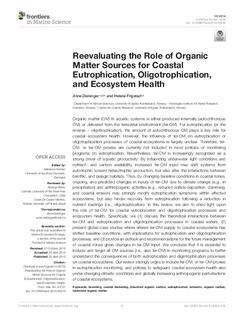| dc.description.abstract | Organic matter (OM) in aquatic systems is either produced internally (autochthonous OM) or delivered from the terrestrial environment (ter-OM). For eutrophication (or the reverse – oligotrophication), the amount of autochthonous OM plays a key role for coastal ecosystem health. However, the influence of ter-OM on eutrophication or oligotrophication processes of coastal ecosystems is largely unclear. Therefore, ter-OM, or ter-OM proxies are currently not included in most policies or monitoring programs on eutrophication. Nevertheless, ter-OM is increasingly recognized as a strong driver of aquatic productivity: By influencing underwater light conditions and nutrient- and carbon availability, increased ter-OM input may shift systems from autotrophic toward heterotrophic production, but also alter the interactions between benthic, and pelagic habitats. Thus, by changing baseline conditions in coastal zones, ongoing, and predicted changes in inputs of ter-OM due to climate change (e.g., in precipitation) and anthropogenic activities (e.g., reduced sulfate deposition, damming, and coastal erosion) may strongly modify eutrophication symptoms within affected ecosystems, but also hinder recovery from eutrophication following a reduction in nutrient loadings (i.e., oligotrophication). In this review, we aim to shed light upon the role of ter-OM for coastal eutrophication and oligotrophication processes and ecosystem health. Specifically, we (1) discuss the theoretical interactions between ter-OM and eutrophication and oligotrophication processes in coastal waters, (2) present global case studies where altered ter-OM supply to coastal ecosystems has shifted baseline conditions, with implications for eutrophication and oligotrophication processes, and (3) provide an outlook and recommendations for the future management of coastal zones given changes in ter-OM input. We conclude that it is essential to include and target all OM sources (i.e., also ter-OM) in monitoring programs to better understand the consequences of both eutrophication and oligotrophication processes on coastal ecosystems. Our review strongly urges to include ter-OM, or ter-OM proxies in eutrophication monitoring, and policies to safeguard coastal ecosystem health also under changing climatic conditions and globally increasing anthropogenic perturbations of coastal ecosystems. | nb_NO |

